Related Research Articles

The Housing & Development Board, is a statutory board under the Ministry of National Development responsible for the public housing in Singapore. Established in 1960 as a result of efforts in the late 1950s to set up an authority to take over the Singapore Improvement Trust's (SIT) public housing responsibilities, the HDB focused on the construction of emergency housing and the resettlement of kampong residents into public housing in the first few years of its existence.

Tampines is the regional centre of the East Region of Singapore. With a population of 274,360 living across its five subzones as of 2023, it is the second-most populous planning area in Singapore. It is home to approximately 5% of Singapore's population. Tampines is bordered to the west by Bedok and Paya Lebar, to the north by Pasir Ris, to the east by Changi, and to the south by the Straits of Singapore. Situated in the historical region of Tanah Merah, its present-day terrain is particularly flat due to the large-scale sand quarrying in the 1960s.
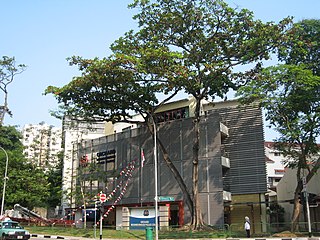
A neighbourhood police centre is a small to mid-sized police station commonly found in Singapore. It was first introduced during the mid-1990s.
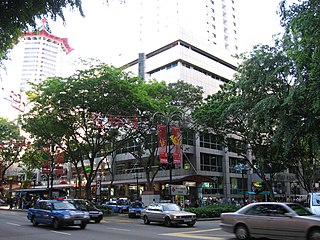
Lucky Plaza is a shopping centre located in Orchard in Singapore. Built by developer Far East Organization, Lucky Plaza was completed in 1981 and has proven to be one of the most successful shopping centres in Singapore.

Tanjong Rhu, is a subzone within the planning area of Kallang, Singapore, as defined by the Urban Redevelopment Authority (URA). The perimeter of Tanjong Rhu is made up of Nicoll Highway in the north; Mountbatten Road and Fort Road in the east; East Coast Parkway (ECP) in the south; as well as Marina Channel and Kallang Basin in the west. Tanjong Rhu is the largest in terms of physical area among the nine subzones that make up Kallang.
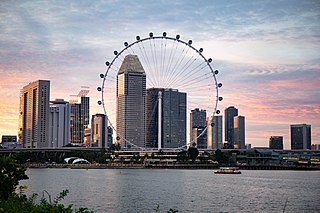
This article shows the notable future developments in Singapore. Most of them are currently under construction with most to be completed within the next five years.

Tanglin is a planning area located within the Central Region of Singapore. Tanglin is located west of Newton, Orchard, River Valley and Singapore River, south of Novena, east of Bukit Timah, northeast of Queenstown and north of Bukit Merah.
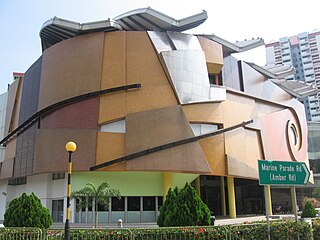
Marine Parade Community Building was a community centre located at 278 Marine Parade Road, Singapore. Opened on 6 March 2000, it houses the formerly separate Marine Parade Community Centre and Marine Parade Public Library, as well as a performing arts group, The Necessary Stage. Designed by William Lim Associates, one of the distinguishing features of the postmodern building is the mural cladding called the "Texturefulness of Life", the largest piece of installation art in Singapore. It was demolished in 2022 and is being rebuilt.

International Plaza is a high-rise commercial and residential building at 10 Anson Road in Tanjong Pagar, within the Downtown Core of Singapore, next to Tanjong Pagar MRT station on the East West line.
A driving licence in Singapore is required before a person is allowed to drive a motor vehicle of any description on a road in the country. Like many other countries in the world, an individual must possess a valid driving licence before being permitted to drive on the road, and driving licence holders are subject to all traffic rules.

The new towns of Singapore are planned communities located across Singapore that are designed to be self contained. Designed to house up to 300,000 residents, these new towns contain areas zoned for housing, recreation and employment, and are composed of multiple neighbourhoods, each of which is further subdivided into multiple precincts. Amenities in these new towns are provided through a multi-tiered system, and based on Housing and Development Board (HDB) guidelines. As of 2022, the country has 24 new towns.
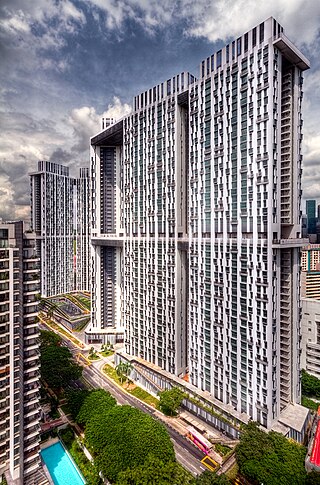
The Pinnacle@Duxton is a 50-storey residential development in Singapore's city center, next to the business district. All seven connected towers are collectively the world's tallest public residential buildings, and featuring the two longest sky gardens ever built on skyscrapers, at 500m each.

Orchard Towers is an 18-story office building in Singapore located on the corner of Claymore Road and Orchard Road. Construction was completed in 1975. The first five floors are a combination of bars and retail outlets with the remainder leased as offices. During the day the building functions as a retail and office style building, but the building is best known as a landmark entertainment complex famously described as the "Four Floors of Whores" or simply the "Four Floors". In addition, one of the towers houses 58 freehold condominium residential units.

One Raffles Place is a skyscraper in Downtown Core, Singapore. The development comprises two towers and a podium. The 280 m (920 ft) tall Tower One and the 38-storey Tower Two house offices, while the podium contains retail space. Initially conceived in the late 1970s as Overseas Union Bank Centre, the headquarters of Overseas Union Bank (OUB), work on the building began in 1981, while construction of the superstructure subsequently commenced in October 1984. Costing S$486 million to build, OUB Centre opened in two phases in June and December 1986, and 90% of its office space was occupied upon opening. At the time of its completion, The Business Times claimed that the complex's tower was the tallest in the world outside the United States.

My Queenstown Heritage Trail is a walking trail in Queenstown, Singapore. The trail was launched in 2010 by civic group, My Community, to promote the heritage, local culture and architectural styles in Queenstown.

Canberra Plaza is a New Generation Neighbourhood Centre (NGNC) built by the Housing & Development Board (HDB), the government agency in charge of public housing development in Singapore. It is one of the new Neighbourhood Centres (NCs) constructed by HDB in 10 years after the completion of Pioneer Mall and Punggol Plaza in 2004. CNN reported that Canberra Plaza will provide a "complete live-work-play-learn environment for residents and signifies Singapore's public housing for the future".

Tanglin Halt is a public housing estate, planning subzone and former industrial estate in Queenstown, Singapore. Most of the older buildings in the estate are set to be demolished by 2024 to make way for redevelopments under the Selective En bloc Redevelopment Scheme. It is the third housing estate to be redeveloped under the scheme.
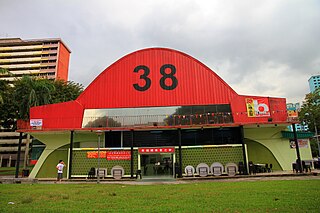
Commonwealth Avenue Wet Market, also known as Queenstown Market, is a former wet market on Commonwealth Avenue in Queenstown, Singapore. It is the only remaining market designed by the Singapore Improvement Trust.

Shenton House is a building on Shenton Way in the Central Area of Singapore featuring a shopping podium underneath a 20-storey commercial tower. It was among the first buildings in Singapore to feature such a design.

Maxwell Chambers Suites, formerly known as the Traffic Police Headquarters or the Traffic Police Building, and later as the Red Dot Traffic Building, is a historic building on Maxwell Road in Chinatown, Singapore. It initially served as the Police Barracks and the headquarters of the Traffic Police branch of the Singapore Police Force, which moved into the building in 1930. In 1941, the first driving test centre in Singapore was established within the building. It ceased operations in 1978 to relieve congestion in the area.
References
- ↑ "Wait is over for 20,000". The Straits Times . Singapore. 3 December 1968. Retrieved 24 June 2024.
- ↑ "70 Per Cent Failed Driving Tests". Eastern Sun. Singapore. 24 February 1969. Retrieved 24 June 2024.
- 1 2 "Queenstown Driving Test Centre". Roots. National Heritage Board . Retrieved 21 June 2024.
- ↑ "Motorists get another road tax centre". New Nation. Singapore. 29 May 1973. Retrieved 24 June 2024.
- ↑ "Two more floors for driving centre". The Straits Times . Singapore. 22 July 1975. Retrieved 24 June 2024.
- ↑ "PDLs: Renewals now at post offices". The Straits Times . Singapore. 26 October 1976. Retrieved 24 June 2024.
- ↑ "First weekend tests for L-drivers at Queenstown". New Nation. Singapore. 7 February 1977. Retrieved 24 June 2024.
- ↑ "Driving tests seven days a week". The Straits Times . Singapore. 29 January 1977. Retrieved 24 June 2024.
- ↑ "Driving tests outside the CBD". The Straits Times . Singapore. 3 September 1977. Retrieved 24 June 2024.
- ↑ "New ROV unit to upgrade driving schools". New Nation. Singapore. 27 March 1978. Retrieved 24 June 2024.
- ↑ "Neighbourhood police centres to be set up soon". The Straits Times . Singapore. 15 July 1997. Retrieved 24 June 2024.
- ↑ "Queenstown police centre brings quicker response". The Straits Times . Singapore. 21 December 1977. Retrieved 24 June 2024.
- ↑ Zaccheus, Melody (15 December 2014). "Farewell for former Queenstown Driving Test Centre". The Straits Times . Singapore.